| The film version | Historical "facts" |
The opening text of the film boldly proclaims that, "During the 17th Century the Spanish Main was overrun with pirates, foremost of whom was Edward Teach, the evil and immortal Blackbeard." |
Blackbeard's career as a pirate captain lasted two years, from 1717-1718 (in the 18th century). While he did plunder in the Caribbean, basing himself in the Bahamas (not Jamaica), more of his time was spent in the North American colonies, where he managed to ingratiate himself to Governor Eden of North Carolina, who is even alleged by "Captain Johnson" to have presided at Teach's nuptials (to his 14th wife, a girl of 16). |
| The text goes on to inform the viewer that "Sir Henry Morgan, who was then in the service of the king, had been sent to clear the seas of the very pirates he once had led." | This aspect of the film is based on truth but it still takes license with it. The real Morgan began his career as a privateer, commissioned by the king to fight the Spanish, primarily in the Caribbean, and his brutality was legendary. Following the 1670 Treaty of Madrid, he continued his plundering, apparently not having received word that England was now at peace with Spain, and proceeded to commit his most infamous deed, the sacking of Panama. As a result, both he and his sponsor, Governor Modyford of Jamaica, were sent to England in chains by order of Charles II. Arriving in London, however, Morgan was not imprisoned, due to his being "very sickly" (Cawthorne), and was treated like a hero. In 1674, on the theory that "it takes a thief to catch a thief," he was sent back to Port Royal, Jamaica, and given the titles of Lieutenant Governor (which simultaneously conferred a knighthood) and judge of the Vice Admiralty Court, in which capacity he prosecuted pirates. (Due to a shipwreck en route, he did not arrive in Jamaica to take his post until 1676.) However, there appears to be no record of his personally chasing down pirates at sea as shown in the film; his worsening health would have precluded such strenuous voyages. |
| The voiceover narration begins: "One night when Morgan was at sea, the ship of the pirate Charles Bellamy came creeping into the harbor and passed unharmed under the guns of the fort." Bellamy's body is soon seen hanging from the yardarm of Blackbeard's ship. | While Blackbeard and Bellamy may have encountered each other at the pirate hotbed of the 1710s, New Providence in the Bahamas (not Port Royal), Charles Bellamy spent most of his career plundering ships on the New England coast from 1717-1720. Considering Blackbeard died while Bellamy's career was still going strong, it is certain that Bellamy's body never hung from Blackbeard's yardarm. (Charles Bellamy is often confused with Captain Samuel Bellamy, who was killed in 1717 when his ship, the Whydah Galley, sank off the coast of Cape Cod. The Whydah, discovered in the mid-1980s, is the only positively identified pirate-ship wreck yet to be recovered. Another shipwreck believed to be Blackbeard's Queen Anne's Revenge was discovered in 1996.) |
| The narrator continues: "I, Edward Maynard, disguised as a down-at-the-heels surgeon ..." (The character later introduces himself to Blackbeard as Robert Maynard. When he bumps into his Uncle Jeremy at Morgan's fort, he too addresses him as Robert.) | Lieutenant Robert Maynard, of the HMS Pearl, was the active-duty naval officer dispatched by the governor of Virginia to put an end to Blackbeard's plundering. A detailed, eyewitness report of their bloody battle is part of the official record. (Adding to the implausibility of the plot itself, it is difficult to imagine how a bounty hunter could disguise himself as a surgeon, especially when called upon to perform delicate surgery, as he is in the film!) |
| The narrator concludes: "... [I] had been haunting the Port Royal waterfront, waiting for something like this to happen. For the governor of Jamaica believed that Morgan was a pirate still and had a quick fortune ready for the man who could prove it. I wanted that quick fortune." | Governor John Vaughan of Jamaica, who had succeeded Morgan's cohort Sir Thomas Modyford, did indeed persecute his Lieutenant Governor, having Morgan brought repeatedly before the Jamaican Council on miscellaneous charges of which the accused was always acquitted thanks in part to his popularity. [In fact, what Vaughan suspected Morgan of was not overt piracy but that "he was clandestinely arranging private commissions with his old friend Governor d'Ogeron of Saint Domingue and taking 10 percent of the profits" (Cawthorne).] (Meanwhile, after spending two years in the Tower of London without a trial, Modyford had also been sent back to Jamaica to serve as chief justice.) Rather than sailing the high seas, Morgan spent increasing amounts of time haunting the taverns of Port Royal, and Vaughan finally succeeded in having him "suspended from office for disloyalty and drunken disorder" (Cordingly, 1996). Vaughan was eventually recalled as governor, to be replaced temporarily by Morgan himself, but Morgan was in turn removed from office in 1682 by returning interim governor Sir Thomas Lynch.
As for the film's setting of Port Royal, on June 7, 1692 (four brief years after Morgan's death yet a full quarter century before the start of Blackbeard's career), the city known to contemporaries as "the richest and wickedest city in the New World" was obliterated first by an earthquake and then by the tidal waves that followed, taking Morgan's ceremoniously interred remains with them. What little of the city that was not permanently submerged was rebuilt (on the site of present-day Kingston) and ceased to be a haven for pirates. By Blackbeard's time, the hotbed of piracy in that region had been relocated to the then-ungoverned island of New Providence in the Bahamas, known today as Nassau, which Blackbeard and over 500 of his contemporaries, including close associates Stede Bonnet, Benjamin Hornigold, and Charles Vane (none of whom is mentioned in the film), made their home base. When former privateer Woodes Rogers was appointed governor of the Bahamas in 1717 and set about his successful campaign to suppress piracy, Blackbeard relocated his base of operations to North Carolina. |
| Blackbeard complains, "There 'e sits, up there in 'is castle, the great Sir Henry Morgan, with all the loot o' Panama—gold, silver, jewels—that's what 'e's sittin' on up there." The "castle" he refers to is the fortress in which Morgan resides. (Later, "all the loot o' Panama" somehow manages to fit into the false bottom of a trunk.) | Morgan was in fact quite wealthy, coming from a landowning family and owning several plantations in Jamaica, but history does not record that his riches were amassed in Panama, where the loot shared out amounted to only about £18 a man. If he did, in fact, cheat his crew and return to Jamaica with immense spoils, the unamused government would surely have demanded its share upon summoning him and Modyford to London in chains. At any rate, Morgan did not reside in a fortress hoarding up treasure but, rather, when not squandering his money in the local taverns, he "spent much of his time supervising his estates" (Cordingly, 1995). |
| The name emblazoned across the stern of Blackbeard's (formerly Bellamy's) three-masted ship is theBristol Queen. | Anybody who knows the first thing about Blackbeard knows his flagship was called the Queen Anne's Revenge, which is never shown or made mention of in the film. His fleet eventually grew to include three other vessels captured as prizes: the Adventure; the Revenge (command of which he had taken from "gentleman pirate" Stede Bonnet, who remained among Blackbeard's crew), and another unnamed sloop. In 1718, the Queen Anne's Revenge and the other sloop ran aground in Topsail (or Beaufort) Inlet—some say it was by design so that Blackbeard could cheat his oversized crew of their share of the spoils—and he went off with 40 of his original 400 men in the Adventure, the sloop from which he engaged Lt. Maynard in his final battle. (Though nothing is known with certainty about his early life, some sources report that Blackbeard hailed from Bristol, which could explain the name Bristol Queen. But the vessel shown in the film is definitely not a sloop, that is, a small vessel of only one mast!) |
| From aboard the ship, the Bristol Queen appears to have only one cramped level below the main deck, with prisoners being thrown directly from the main deck into the hold. Yet early in the film, Blackbeard orders a member of his crew to give up his cabin and move to the orlop deck. | The large, three-masted ship shown in longshots would have at least one gundeck above the waterline and an orlop deck below it, with the hold lying below that (just above the bottom of the ship, or bilge). |
| "Whereat did you learn your doctorin'?" asks Blackbeard, to which Maynard replies, "Two years on a privateer corvette, theSwallow." Blackbeard instantly recognizes the name: "The Swallow? Ar, the old 'Gulp 'Er Down.' Apirate surgeon." | The name Swallow is merely the set-up to more of Blackbeard's suggestive avian humor (see memorable lines). There were in fact two famous historical ships named the Swallow: The first was commanded by Sir John Hawkins, cousin to national hero and original privateer Sir Francis Drake, during the 1500s. The second was the 50-gun naval warship that put a decisive end to the dread pirate Bartholomew Roberts's career in 1722. (Neither Swallow was a corvette, a class of ship just below a frigate usually mounting only 18 guns.) |
| Blackbeard's second in command is a goofy lummox named Ben Worley. | There was, in fact, a pirate captain named Worley or Worsley who sailed from New York in 1718. He was clearly not a goofy lummox, though, as he managed to begin his career with a crew of only eight and soon captured several prizes before he was killed in battle off South Carolina. Governor Johnson personally led the attack against him due to the state of high alert in Charleston following recent raids by Blackbeard and his associates.
Meanwhile, Israel Hands, real-life ship's master and pilot (two positions which required considerable technical knowledge and skill) under Blackbeard is mentioned in passing but conspicuously absent from the film. His competence was at least such that he was trusted with command of Blackbeard's prize, the Adventure. However, Hands left the crew after Blackbeard, playing a practical joke, lamed him with a gunshot to the knee. It is through his eyewitness testimony that we know anything reliable about Blackbeard's shipboard exploits. (Robert Louis Stevenson borrowed Hands's name for the character of the coxswain aboard the Hispaniola, formerly Captain Flint's gunner, in Treasure Island, and he turns up again in another Robert Newton movie: Long John Silver's Return to Treasure Island.)
|
| "Fiery wench" Edwina Mansfield (Linda Darnell) and her "lady in waiting" are welcomed aboard Blackbeard's ship with open arms in the film. They roam the ship freely, and the beautiful, seductively clothed Edwina's honor is only momentarily threatened. | Real-life pirates had strict rules forbidding women aboard their ships, some say due to superstition, and, from a practical standpoint, in order to prevent the lack of discipline their presence tended to cause among the men. Any female prisoners aboard a pirate ship would have been heavily guarded. Further, because of rampant piracy, few women of the time dared to travel by sea in the Caribbean except under the protection of a Naval ship. |
| Edwina is both fiancée to Captain Charles Bellamy and daughter to renowned pirate Edward Mansfield, "commander of all the Brethren of the Coast and ... the blackest pirate whatever until Ned Teach." It is also suggested that Edwina is Morgan's niece, although he proposes marriage to her. | In 1666, Dutch pirate Edward Mansvelt (anglicized to Mansfield) was indeed elected "admiral" of a fleet of 600 buccaneers (referred to in later literature as the "Brethren of the Coast") at the urging of Governor Thomas Modyford of Jamaica, who sought to protect his island from Spanish attacks. However, even in 1663, when he took part in Sir Christopher Myngs's campaign against the Spanish, Mansfield was described not as "the blackest pirate whatever," but as an "elderly man," and he died in 1667, shortly after returning from the campaign. Henry Morgan (nephew of the late Colonel Edward Morgan, who had also been in Modyford's employ and was said by Exquemelin to have served as Mansfield's vice-admiral) was promptly elected his successor. (Since Morgan was born in Wales many years later than Mansfield, it is highly unlikely that he could have been uncle to Mansfield's daughter, if indeed he had one living in the Caribbean.)
Further, the film's premise in which Mansfield's daughter meets Morgan the lieutenant-governor/pirate hunter must have taken place sometime between 1676 and 1682, while her betrothed, Charles Bellamy, did not begin pirating until 1717, about the same time as Blackbeard. |
| The leading man (Keith Andes) of the film looks to be a good two inches taller than the title character. | The real Blackbeard was renowned for his terrifying appearance; the mere sight of him was generally enough to cause his intended prey to surrender without a fight. Part of this was due to his physical stature; during a time when men rarely grew to the height of 6 feet (Robert Newton's actual height), Edward Teach was said to stand 6'5". Surely this illusion could easily have been accomplished on film, even with the limited technology available in the 1950s. |
| Blackbeard decorates his long beard with red ribbons and has fierce-looking, wild eyes. | When preparing for battle, Blackbeard was reputed to decorate his long beard (or hat) with lit fuses that wreathed his head in smoke and added to his frightening appearance, a successful deterrent to prey thinking of giving fight. "Captain Johnson" elaborates: "his eyes naturally looking fierce and wild, made him altogether such a figure that imagination cannot form an idea of a fury from hell to look more frightful." (Indeed, the tactic seemed to have worked, for, although he took many prizes, there is no official record of Blackbeard's ever having engaged in battle until his fateful encounter with Maynard's sloop in Okracoke Inlet—at which time he did not sport the forbidding lit fuses in his hat or beard. To be fair, red ribbons are not mentioned in Lt. Maynard's report either.) |
| Sir Henry Morgan appears in the film to be fit, annoyingly jaunty, and in excellent health. | A Port Royal doctor, Sir Hans Sloane, described Morgan as "lean, sallow-colored, his eyes a little yellowish and belly jutting out or prominent" and later reported that, due to his continued heavy drinking, "his belly swelled so as not to be contained by his coat," diagnosing him with "dropsy." On August 25, 1688, two days after being administered a highly unconventional treatment from a local Voodoo practitioner, Sir Henry Morgan died at the age of 53. |
| Much of the plot revolves around treasure burial in the Caribbean. On completion of the laborious task, Blackbeard tells the object of his toil, "Ar, only the devil and I know where you are now." | This aspect of the film is at least based on legend. It goes without saying nowadays that, with very rare exceptions, real pirates weren't frugal enough to bury their treasure (nor did they make their enemies "walk the plank"). Most squandered their booty the moment they set foot ashore and died in poverty. However, Blackbeard is alleged to have been one of the rare exceptions. The story goes that, on the night before his final battle, when asked if his wife knew where his treasure was buried, he replied that "nobody but himself and the devil knew where it was and the longest liver should take it all." (One supposed eyewitness alleged that Blackbeard together with his crew buried their loot on an island in the York River in Maryland. However, this lead was followed up and, not surprisingly, no treasure was found. According to Pringle, "Blackbeard never took enough loot to make his share worth burying.") |
| Blackbeard is dogged by Edward/Robert Maynard; however, Maynard makes clear early on that it is not Blackbeard but Morgan he is after. [Warning: plot spoiler!] Later on, Blackbeard is cruelly done in by his own disgruntled crew on a Caribbean island. | In reality, Blackbeard was hunted down, along with his crew, and killed in a bloody and dramatic hand-to-hand shipboard battle in November 1718 at Okracoke Inlet in North Carolina. The attack was led by Lieutenant Robert Maynard, by order of Governor Spotswood of Virginia. Even after sustaining five gunshot wounds and twenty deep stab wounds, including a slashed throat and a bullet in his chest (fired at close range), Blackbeard fought on fiercely, breaking Maynard's sword in two before finally succumbing to his injuries and falling dead on the deck. His decapitated head was hung from the bowsprit of Maynard's sloop, while his body was flung overboard. (Legend has it that it swam several times, Rasputin-like, around the ship before sinking to the bottom!) By the end of the piracy trials, only two of Blackbeard's crew survived: one man who had joined the crew only the day before and Israel Hands. |
| Blackbeard is depicted as a narcissistic (if charming), conniving, cold-blooded murderer. | In the words of Patrick Pringle, Blackbeard is "probably the most maligned pirate in history. He ... never fought if he could avoid it. ... He did not terrorize his prisoners, and there is not a shred of evidence to show that he ever ill-treated one of them. He threatened murder at [the siege of] Charleston, but did not keep his word when the time-limit expired [and the medicines he demanded were not delivered]. When he took prizes he usually put the crews ashore and burnt their vessels. If this was not possible he merely took the cargoes and let the men keep their ship, although it would have been safer to sink her with all hands. ... Blackbeard fought bravely at the end, but this was the only occasion on which he ever had to fight." |
 The beginning of the life of Blackbeard is shrouded in mystery – although thought to have been born and raised in Bristol, other schools of thought have suggested that Teach was born in Jamaica. It is also unknown if ‘Teach’ was the true family name of this man. An unconfirmed source suggests he might, in fact, have been named Edward Drummond, and in later documents he has also been referred to as Edward Thatch. Nevertheless, when he began his career on the high seas, sailing from Jamaica aboard a privateer during the War of the Spanish Succession, he was using the name Edward Teach, or a variation thereof.
The beginning of the life of Blackbeard is shrouded in mystery – although thought to have been born and raised in Bristol, other schools of thought have suggested that Teach was born in Jamaica. It is also unknown if ‘Teach’ was the true family name of this man. An unconfirmed source suggests he might, in fact, have been named Edward Drummond, and in later documents he has also been referred to as Edward Thatch. Nevertheless, when he began his career on the high seas, sailing from Jamaica aboard a privateer during the War of the Spanish Succession, he was using the name Edward Teach, or a variation thereof.
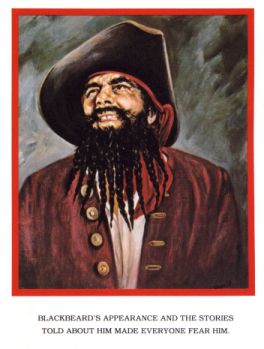 Since the 1950s, thanks to the influence of his original and unforgettably charismatic portrayals of both
Since the 1950s, thanks to the influence of his original and unforgettably charismatic portrayals of both 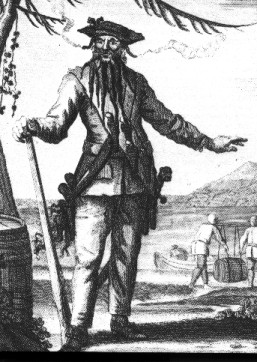










.jpg)







.jpg)











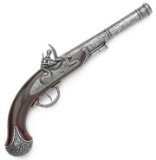


 for the Spanish word for pomegranate, which they resembled. They could be small glass bottles or little pots made of clay, wood, or iron that were filled with black powder mixed with broken glass or scraps of iron and lit with a fuse. Good for shrapnel wounds and shock value.
for the Spanish word for pomegranate, which they resembled. They could be small glass bottles or little pots made of clay, wood, or iron that were filled with black powder mixed with broken glass or scraps of iron and lit with a fuse. Good for shrapnel wounds and shock value.
 - a box or cage or canister filled up with grape, bundle shot, or stones to get the fight over with.
- a box or cage or canister filled up with grape, bundle shot, or stones to get the fight over with.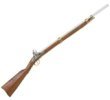
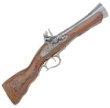
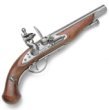
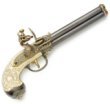
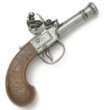
 - Whether in pistol or rifle form, these pirate weapons would fire their several barrels at once, forming a kind of dotted line that you were daring any boarders to cross. Remember, there ain't no breech loading of these things, so the operator would need to ask for a time-out in the battle just to reload.
- Whether in pistol or rifle form, these pirate weapons would fire their several barrels at once, forming a kind of dotted line that you were daring any boarders to cross. Remember, there ain't no breech loading of these things, so the operator would need to ask for a time-out in the battle just to reload.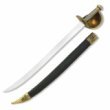
 used with lines to pull ships closer, which were then lashed together for the boarding.
used with lines to pull ships closer, which were then lashed together for the boarding.